Soap Box Derby
The Soap Box Derby is a youth-oriented soap box car racing program which has been running in the United States since 1934. Proclaimed "the greatest amateur racing event in the world," the FirstEnergy All-American World Championship is held each July at Derby Downs in Akron, Ohio with winners from their local communities travelling from across the US, Canada, Germany and Japan to compete. 2023 marks the 85th running of the All-American since its inception in 1934 in Dayton, OH, having missed four years (1942-1945) during World War II and one (2020) during the COVID pandemic. Cars competing in this and related events race downhill, propelled by gravity alone.
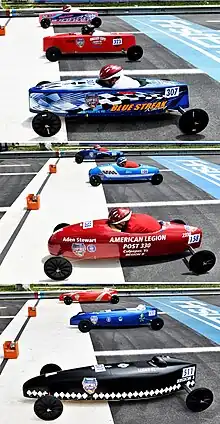
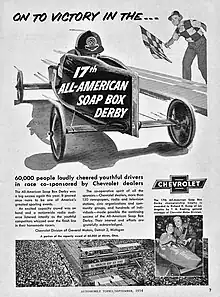
The Soap Box Derby expanded quickly across the US from the very beginning, bolstered largely by a generous financial campaign by its national sponsor, Chevrolet Motor Company. At the same time there was enthusiastic support from coast to coast of numerous local newspapers that published aggressively during the summer months when races were held, with stories boasting of their own community races and of their Champion travelling to Akron with dreams of capturing a National title and hometown glory. In 1936 the All-American had its own purpose-built track constructed at what is now Derby Downs, with some communities across America following suit with tracks of their own.
Its greatest years occurred during the Fifties and Sixties when viewer turnout at the All-American reached 100,000 spectators, and racer participation was at an all-time high. From the very beginning, technical and car-design innovation happened rapidly, so Derby officials drafted ways of governing the sport so that it did not become too hazardous as speed records were being challenged. At Derby Downs the track length was shortened twice to slow the cars down.
The seventies brought significant changes, beginning with the introduction of girls to the sport in 1971. The following year Chevrolet dropped its sponsorship, sending Derby Downs into a tailspin that threatened its very future. Racer enrollment plummeted the following year. In 1973 a scandal hit Derby Downs with the discovery that their World Champion had cheated, and was thus disqualified, further exacerbating an uncertain future. In 1975 Karren Stead won the World Championship, paving the way for more girls to get involved. Today they excel at the sport. Finally there was Derby's decision to divide the competition with the introduction of the Junior Division kit cars in 1976.
As fiscal challenges continued, the Derby instituted new guidelines by redrafting the Official race divisions into three: Stock, Super Stock and Masters. With it came the availability of the prefabricated fiber glass kit racers which kids could now purchase, this to appeal to a new generation of racers uncomfortable with constructing their own cars from scratch, as well as to help Derby effectively meet its financial obligations. Leading into the 21st Century it has continued to expand with the inclusion of the Rally Program racers at the All-American in 1993, the creation of the Ultimate Speed Challenge in 2004 and the Legacy Division in 2019.
Introduction
The Soap Box Derby, promoted as "the greatest amateur racing event in the world,"[1] is a largely volunteer-driven,[2] family-oriented sporting activity for youth conducted across the US and around the world. Local or regional races are held yearly, with winners from each sent to compete at the All-American Soap Box Derby World Championship, officially the FirstEnergy All-American Soap Box Derby World Championship,[3] which occurs every July at Derby Downs in Akron, OH. Oversight is by the All-American Soap Box Derby organization, or AASBD, run by a paid administrative staff[2][4][5] headquartered at Derby Downs.
The name Soap Box Derby[lower-alpha 1] is a registered trademark,[1] and used to identify the sport overall, with those actively involved referring to it simply as "Derby." The official name FirstEnergy All-American Soap Box Derby is used solely to identify the annual World Championship race itself, and referred to similarly as "the All-American."[6]
Eligibility to race in the Soap Box Derby is open to anyone aged 7 through 20, with participants divided by age into three Divisions, with a specific car design assigned for each: Stock, the entry level Division for ages 7–13, Super Stock, for mid-level kids ages 9–18, and Masters, the senior level for ages 10–20 and a design where the occupant rides in the fully reclined position. Cars come un-assembled in kits purchased from the AASBD, the only visibly common component of all three designs being the Official wheels sets which are available for purchase as well.[7]
While working with a mentor is permitted, kids are expected to assemble the cars themselves in order to develop the skills necessary for the car to pass inspection before they are qualified to race.
Beginnings
Kids playing on home-made scooters and go karts in the 1930s was not an unfamiliar sight in the streets of America, and racing in organized events was an inevitable outcome of it. As early as 1904 Germany conducted its first soapbox race for kids, and in 1914 there was the Junior Vanderbilt Cup in Venice, CA that held a kids race as well.[lower-alpha 2]
The Soap Box Derby story began on June 10, 1933[9] when six boys were racing homemade push carts in Dayton, OH, among them William Condit whose father suggested they have a race and that he would contact the local newspaper to have them cover it. The other participants were Dean Gattwood, Tracey Geiger, Jr., Robert Gravett, James P. Hobstetter and William Pickrel, Jr.. Of the six, Condit won that race, with Gravett taking second.[10]
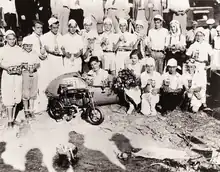
Myron Scott, a 25-year-old photojournalist for the Dayton Daily News looking for ideas for its Sunday Picture Page, was one of two photographers that got the call,[9][12] and accepting the assignment ventured out to investigate. Seeing the appeal of a kids story like this he asked the boys to return in two weeks with more of their friends so he could host a race of his own. When they did nineteen showed up, bringing with them racers made of packing crates and soap boxes, sheets of tin and whatever else they could find. The race was held on Big Hill Road in Oakwood,[13] a south-side neighborhood of Dayton, with a crowd of onlookers coming to watch. Seizing on a publicity opportunity, Scott decided to plan an even bigger city-wide event with the support of his employer, the Dayton Daily News, which recognized the hope-inspiring and goodwill nature of the story—especially during the Depression. It posted advertisements of it almost daily to stir interest, and included an application which stipulated "for anything on four wheels that will coast"[9][14] for the kids to fill out. A date was set for August 19, 1933 to host a parade,[13] the race to occur a day after, and the location chosen as Burkhardt Hill, a straight, westbound slope on Burdhardt Ave[lower-alpha 4] east of Downtown Dayton.
On the appointed weekend a turnout of 460 kids along with 40,000 onlookers[13] caught everyone by surprise, and Scott knew he was onto something big. From the original 460 cars, 362 were deemed safe enough to participate,[15] including Robert Gravett, the only boy from the original Oakwood six that made an appearance.[9] At day's end sixteen year old Randy Custer (pictured), who also hailed from Oakwood, took the championship in his "slashing yellow comet"[14] on three wheels, with eleven year old Alice Johnson—who shocked many when they saw she was a girl after removing her helmet—taking runner-up.[16][2]
Scott immediately set about making the race an All-American event the following year, and sought a national sponsor, selling the idea successfully[17] to the Chevrolet Motor Company to co-sponsor with the Dayton Daily News. He was also able to induce many newspapers from coast to coast to sponsor local races on the merits that the story would increase circulation. From the photographs taken at the very first race of the six boys, he selected runner-up Robert Gravett's entry as the archetypal soap box car, and designed it into the national logo along with the now official name, Soap Box Derby, which became a registered trademark.[18]
First All-American
The very first All-American Soap Box Derby race was held on August 19, 1934 at the same location as the Dayton city-wide race in 1933, on a track that measured out at 1,980 feet. Watched by a crowd estimated at 45,000,[19] boys from 34 cities compete in the all day affair, with Robert Turner of Muncie, Indiana, piloting a car riding on bare metal wheels with no bearings, becoming the first All-American Champion. Charles Baer of Akron won the All-Ohio Championship, and in a separate race category called Blue Flame for boys aged 16 to 18, Eugene Franke of Dayton, piloting a scaled-down version of a professional motorized racer, took the crown.[19]
In 1935 Akron civic leaders convinced program organizers to move the event to Akron, OH due to its central location and hilly terrain. A long, eastbound grade on Tallmadge Ave. located at the east end of the city,[lower-alpha 5] and the site of 1934 Akron local race, was used for this year's national event, and a date was set for August 11, 1935. Scott decided to discontinue the Blue Flame race category as turnout last year was low. Fifty-two champs from across the nation made the trip to Akron, greeted by a throng of 50,000 on race day, with Maurice Bale of Anderson, IN in a sleek, metal-clad racer taking the top prize. One mishap was an accident that captured the public's interest, even boosting the event's profile worldwide, when a car piloted by Oklahoma City's Paul Brown went off the track and struck NBC's Graham McNamee and Tom Manning while they were broadcasting, an incident that continued being described live on the air as it happened.[20]
Selling Derby
The Soap Box Derby swept across America quickly during the Depression when dreams of winning the All-American became quite popular with boys. Within a year of its inauguration, tens of thousands of them were constructing racers[21] for a chance to travel to Akron for fame and glory.[22] The added inducement of winning a college scholarship was also a chance at a more promising future,[23] something any parent would want for their child during a time when life was a challenge.[24] Print media made celebrities of winners in Derby events at the local and national level, with world champs having their faces show up on the front page of every newspaper covering the event.[25]
Chevrolet's campaign in promoting the Derby promulgated these ideas, something America needed at the time. However Chevrolet's sponsoring of the Derby was ostensibly a money-making enterprise,[22] and with the Depression well underway by 1934 and programs like the WPA being implemented to bolster the economy,[26] the idea of a kids' recreational program like the Derby—boys in cars—seemed an excellent marketing opportunity to sell its main product—cars—to their parents. During the Depression kids had little access to organized activities like team sports or television,[27] so getting them get behind a singular national event like Derby was an easy sell with an undeniable appeal. Chevrolet dealerships acted as agents for the Derby, where kids would sign up and purchase wheels and axles to get started on their cars, and since a child was usually accompanied by a parent, what better way to get mom or dad—who waited patiently while their child filled out an application—to check out the latest models in the showroom.[28]
Awards
Awards at the All-American started with the first-place silver trophy and a four-year college or university scholarship of their choice. Second and third place were awarded a brand new Chevrolet[2] and a smaller silver trophy similar in design to the first place award. Technical awards went to the best constructed (C.F. Kettering Trophy)[29] and best upholstered entries, as well as the car with the best brake. At the local level, boys that won and qualified to attend the All-American were awarded the M. E. Coyle (silver) Trophy, named after Chevrolet General Manager (1933-1946) M. E. Coyle (1888-1961),[30] and a cash prize. Beginning in 1950, they received the T. H. Keating Award plaque, named after Chevrolet Sales Manager T. H. Keating.[31] Technical honors for cars with best construction, best upholstery and best brake were awarded as well.
Derby Downs
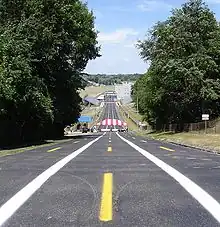
Because of the growing popularity of the event, a larger and more permanent home was needed, and a dedicated track was constructed in 1936. Chief among those that spearheaded the project were Bain “Shorty” Fulton, manager of Akron's Fulton Airport, and Jim Schlemmer, sports editor of the Akron Beacon Journal. A site[lower-alpha 6] was chosen by the airport, a tract of land occupied at the time by a ski slope, which the City of Akron agreed to lease to the Soap Box Derby organization for $1 per year. Following its announcement on July 29, 1936, construction began on a 1,600 feet (490 metres) paved track with landscaping, installation of the rented grandstands and bleachers, and the erection of a wooden, two-deck bridge over the finish line, all by WPA workers. Of the 1,600 feet, 1,175 feet (358 metres) of it was the race course, with the top staging area and bottom run-out comprising the remainder. Extensive infrastructural provisions were made for the expected media as well.[20]
Exactly three weeks later, on August 16, 1936, the first All-American at Derby Downs (officially the 3rd All-American) was run. A pre-race parade with 11 bands entertained a throng of nearly 100,000 who were welcomed officially by Governor Martin L. Davey and Mayor Lee D. Schroy. Competing in the race were 116 boys from across America and one from South Africa, making this the first World Championship. Witnessed by a cadre of 500 media personal from around the globe was 3rd All-American Champion Herbert Muench, Jr. 14, of St. Louis, MO taking home the top prize of a $2,000 four-year college scholarship.
Now that Derby had a home it was able to cater to the increasing participation of still more communities organizing additional local races and sending champs of their own. At the Inaugural All-American the number of boys that entered was 34, but by 1936 that number had exploded to 116. In 1939 there were 176 cities that wanted to participate, but due to Derby Downs' limit to just 120 cars at the time, some communities had to double up or hold regional races in order to send just one boy representing multiple communities instead of two or more. Even by 1935 there were an estimated 50,000 boys across America that were already building cars in order to participate.[32][33]
In 1940 the popularity of the sport meant that the All-American would accommodate 130 cars from around the world, increasing to 148 by the end of the decade. In 1959 that number was raised to 170, and by 1969 a total of 257 cars came to Akron. Today the All-American comprises three Official Divisions across multiple categories, and in 2023 reached 320 participants.[34]
1950s-1960s
Following WWII and a return home of its service personnel, America embraced a new optimism and chance for greater prosperity, thanks partly to the G.I. Bill introduced in 1944.[35] In 1946 the Soap Box Derby returned as well, and Chevrolet wasted no time in marketing the Derby with the same amount of pomp and pageantry it lavished upon the boys half a decade earlier.[36] By now the Derby was a national obsession for many boys who thought of nothing better than to construct their cars in the hopes of making it to Akron. Considered to be Soap Box Derby's heyday or "golden age," attendance at the All-American reached its peak at 100,000 each year. When two or three cars were raced neck and neck, or the hometown boy took his turn down the hill, the cheers from the grandstand would drown out the race announcer over the loudspeaker.
Part of the attraction of the All-American was the parade of celebrities that made appearances annually at the All-American every summer. Names like Abbot and Costello, the cast from TV's Bewitched, Lorne Greene and the cast from Bonanza, Rock Hudson, Richard Nixon, Ronald Reagan, Roy Rogers, Dinah Shore, Jimmy Stewart, and Adam West were promoted by Chevrolet leading up to the annual race.[37] Jimmy Stewart made the most appearances in Akron, six in all—1947-1950, 1952 and 1957. Into the 1970s, other celebrities included Peter Fonda, George Takei[38] and Tom Hanks[39]
The Derby family
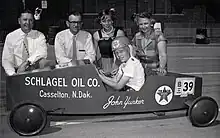
This period witnessed the growth of the Derby family[40] (pictured), with fathers who were once racers themselves now putting their own sons into cars to compete. Often with mom's help or support, even sister, an uncle or cousin throwing in, Derby became a family enterprise where two or more brothers would possibly compete against one another in their local race, or a boy would build a car for each year he competed,[lower-alpha 7] passing it down to a younger sibling as he outgrew it. Soap Box Derby's "boy built" rule was understood—albeit frivolously—to mean that dad could help to some degree with his son's construction of the car, which was most often the case,[43] but the outcome meant that father and son worked together, forging a healthy and long lasting relationship that became the backbone of the Soap Box Derby.[44] As with any sport involving family participation, there were parents wanting nothing more than to win at all cost, particularly since the stakes were so high, with a kid acting simply as jockey, piloting a car that was built by an adult or hired professional.[43][45] This became a growing concern and constant complaint heard around various races,[lower-alpha 8] with officials eventually taking measures to guard against such occurrences.[45]
With each year, Derby regulations were amended and standardized to ensure the safety of drivers. After the war the use of windscreens on cars were still allowed, but by 1948 they were banned outright. Wheels were also standardized with the introduction of the Official Soap Box Derby Tire and axle set that a boy could purchase at his neighborhood Chevy dealership. Weight and dimension restrictions of the car remained generally the same during this time, but as more subtle rules changes were being introduced by the late Sixties, car designs became more creative[46] and even outlandish in response.[47]
Car design
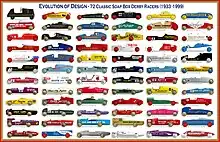
Derby regulations regarding the construction of racers played an integral role in their design. Since the early days, cars had to comply with size and weight restrictions that remained largely unchanged until the mid 1970s. They included a maximum weight of 250 lb (110 kg) for both car and driver (verified during a weigh-in prior to the race),[48] an overall length of no more than 80 inches (200 centimetres), a wheelbase of no less than 40 inches (100 centimetres), height not to exceed 30 inches (76 centimetres) and a wheel tread of between 30 inches (76 centimetres) and 36 inches (91 centimetres). The front axle was to be mounted on a single kingpin, and directional control governed by steel cables, a single steering column and wheel. No ropes were allowed.[49] The brake was to be a friction or drag type, usually an armature through the floor that was activated by a foot pedal. Wheels were to be the solid rubber type, not pneumatic, and measure no more than 12 inches (30 centimetres) in diameter, a limit that began in 1937.[49] Finally the driver was to be seated upright, though the practice was to crouch forward to minimize wind resistance. Pre-race inspections verified that the car was well constructed according to strict observance of the rules, and safe to drive.
The majority of boys built simple-to-construct "soap box" designs—plywood or metal skin over bulkheads affixed to a floorboard, and they fared quite well competitively in them, even in the All-American. Examples of such cars that won in Akron were World Champions Derwin Cooper[lower-alpha 9] of Williamsport, PA in 1951 and Harold "Bo" Conrad[lower-alpha 10] from Duluth, MN in 1963. More skillful entries that became top-tier contenders were made from laminated timber that had to be hand-carved or planed away and then sanded smooth to achieve the desired aerodynamic shape. With floorboards as thick as three inches of solid oak, these cars became quite heavy, which was a useful advantage when drivers were small and slight-weight. World Champion Thomas Fisher[lower-alpha 11] of Detroit, MI won the 1940 All-American in such a car. Peculiar innovations appearing from the late fifties to the late-Sixties were cars fitted with clefts or slots running axially along the fore-deck, called 'sight-grooves',[lower-alpha 12] through which drivers could see ahead while slumped low in the cockpit. By the late-Sixties car design saw the front axles being placed further aft in an attempt to place as much weight of the car rearward, meaning as high up the hill from the finish line, to gain even a hundredth of a second advantage. 1967 World Champion Ken Cline's low-profile racer, called the "Grasshopper",[lower-alpha 13] was the first World Champion with a car configured in this way. Cockpit tonneau covers were also being added to enclose the boy's shoulders, which usually protruded slightly outside the car body, in an attempt to improve aerodynamics. With boys that raced for more than one year and began to outgrow their cars, side blisters would sometimes be fitted to accommodate shoulders or elbows that were becoming cramped. An unusual innovation came in 1968 with "shotgun steering," a design solution in response to a regulation stipulating that the steering column be situated 12 inches (300 mm) above the floor of the car. Many cars by then were being built lower than that, so the column had to be placed above and outside the car body, which ended up looking like a machine gun on a WWI fighter, and thus its name.[46] 1970 World Champion Sam Gupton's car[lower-alpha 14] had this design. It was discontinued after 1971.[50]
Laydowns and "stick cars"
In 1964 the first lay-back or lay-down designs were appearing on the track,[50] this to improve aerodynamics, and by the early Seventies became the status-quo[46] for the most competitive cars, with 1969 being the first year that a lay-down design won the World Championship, piloted by Steve Souter[lower-alpha 15] of Midland, Texas.[51] Introduced also were composite materials being incorporated into the car bodies, quite similar to wooden strip canoes laminated with fiberglass, called "stick car" construction. Beginning in the Seventies,[46] it was used exclusively to build the Senior and later Masters Division racers.
Wheels

Standardized Derby wheels were first introduced in 1936 with the introduction of the Goodrich Silvertown steel wheel that featuring a pneumatic tire measuring 15 inches (38 centimetres) x 1.75 inches (4.4 centimetres) and dust caps that protected the bearings.[52] Though they were not required on the car to compete—as many boys still used wagon or baby-carriage wheels of various dimensions and styles,[53] they were used successfully by Herbert Muench[lower-alpha 16] of St. Louis, MO, who won the 1936 World Championship. The following year the official rule book stipulated a limit on wheel size of no more than 12 inches (30 centimetres), a standard still used to this day, and a requirement that the tire be solid, not pneumatic. In compliance Goodrich Silvertown introduced Derby's first official-issue wheel,[50] made available for sale to within the $4-$6.00 budget set by Derby officials.[49] Like the previous year they comprised two steel halves riveted together—soon to be replaced by welds—and came in a kit that included axles measuring 9⁄16 inch (14 millimetres). Wheel-sets were often in short supply in the early years,[32] and many suppliers took advantage of this by advertising after-market "Derby-type" wheels for sale in newspapers at a cheaper price, or to fill the gap when official issue were unavailable. In 1946 a new wheel, the Firestone Champion, was introduced that measured the same 12" diameter and was painted yellow with green dust cap. The following year they were painted gold, with the dust caps being dropped. In 1951 the same wheel was re-branded the "Official Soap Box Derby Tire" and painted red, becoming the official issue[2] at all Derby events until 1981. In 1982 a new official issue was introduced, the white Z-Glas wheel,[lower-alpha 17] designed by Derby's national sponsor Novar Electronic Corporation,[46] and was used for forty-one years. This was replaced in 2023 by the UniGrip, a black plastic, all-in-one-piece molded wheel and tire measuring the standard 12 inches (30 centimetres), and was used as official issue at the 83rd All-American.[54]
It was quickly understood that the way to victory relied largely on the wheels, and several clever means, some legal, some not, were used to exploit this. Wheel and axle sets came new out of the box when purchased, and competitors quickly learned ways to break in the bearings to make them roll smoothly, or drill small holes in the metal fascia to balance a wheel out. Various lubricants were also experimented with, and other more interesting ways of improving performance involved the rubbing of dry ice on the rubber tire to harden it and thus lower its rolling resistance. Derby Downs quickly identified these techniques, accepting some but banning others.
Suspension
Cars had axles assemblies running through the car body, bolted inside of the car to the topside of the floorboard rather than underneath. This meant that the the weight of the car and its occupant were suspended from the axles by kingpins, with the axles relied upon for their flexibility to act like springs, mitigating the effects from imperfections of the track's surface like cracks and undulations of the pavement. To this day various tightness settings of the kingpins, such as allowing no vertical play whatsoever (called solid), a little play (tight) or free movement (loose),[55] continue to be experimented with to achieve maximum performance of the car in dealing with such imperfections.
Wheel swapping

In 1958 Derby Downs began issuing the commemorative All-American Champion wheel, painted gold, at its World Championship race (pictured), meaning every car had their original wheels swapped with a brand new set, ostensibly to make races more evenly matched at the finish line. This practice continued from 1959 to 1972, with each year's wheel being painted a unique color—silver (1959), robin-egg (1960), blue (1961), silver (1962-25th anniversary) and gold (1962-1972)—with matching water-slide decals on the obverse and reverse side, each year bearing a unique commemorative design. When Chevrolet dropped its sponsorship in 1972, the wheel continued to be painted gold but no longer had the decal. In 1982 the decals began appearing again at the All-American, this time on the obverse side only of the new Z-glas wheel, and again with a design unique to a particular year, but ended in 2001. Further commemorative wheels were issued at the 70th (2007) and 75th (2012) All-American.
To make things as fair as possible for racers,[56] i.e. putting "the fate of the race in the driver's hands,"[57] the practice of wheel swapping continues to this day in concert with lane swapping in double-elimination races.[58][59] Wheel swaps involve two competitors each selecting two wheels from their opponents car and having them put on their own, called a two-wheel "swap-off,"[48] eliminating the advantage of any one car having the better wheels. The initiative has received criticism for making races take too long.[60]
1970s
In the late Sixties enrollment at the Soap Box Derby was at an all-time-high, with craftsmanship and car design exploring innovative new concepts that favored drivers in a full lay-down position instead of the standard sit-up configuration. The Seventies held great promise for the Derby, which anticipated expansion of the sport ushering a new generation of drivers, however social pressure brought on by the Women's Liberation Movement demanded that institutions like the Soap Box Derby embrace more modern trends. In 1971 it was announced therefore that girls would be allowed to race for the first time.
Girls join Derby

In 1933 Alice Johnson (1921-1985) was one of two girls[2] to race at the very first city-wide soap box race in Dayton, having constructed her car with the help of her father, Dayton aviator Edward "Al" Johnson. Taking second, she was awarded a bouquet of flowers from winner Randall Custer, and a boy's bike. The following year she raced again in the Dayton local race, taking third.[61]
No Derby Rule Book ever stated that girls were unable to compete officially, but it was suggested in the language of promotional material and newspaper advertisements, with Chevrolet dealerships even refusing to accept girl applicants or sell them wheels and axles.[62] There was also resistance from many, including its founder Myron Scott, who stated that he devised the sport to be exclusively 'boys only' from the start.[11] Counter to this, popular opinion was positing a more liberal stance, with Chevrolet receiving legal pressure from local Derby organizations wishing to enter girls. This coupled with that fact that former racers that were now dads wanted to participate in Derby once more by putting their child into a car, but only had daughters. Mason Bell, general manager of the Soap Box Derby from 1964 to 1972, knew that it was only a matter of time before girls be let in.[63]
Unlike most organized sports, the Soap Box Derby chose not to split competition along gender lines by creating a separate category for each, meaning that girls would go up against boys on an equal footing. At the 34th All-American, Rebecca Carol Phillips was the very first girl to take a run down the track at Derby Downs, racing the first heat in lane 1, and winning it.[64] The following year two girls cracked the top ten in a field of 236 entries: Priscilla Freeman of Chapel Hill, NC, who took 5th, and Karen Johnson of Suburban Detroit, MI, who came 7th.[65] In no time the girls equaled the boys,[66] and in 1975 the first female World Champion honor fell to Karren Stead, 11, (her car pictured) of Lower Bucks County, PA., who not only won but did so in an arm cast[lower-alpha 18] she acquired a few days earlier after an injury at Derby Camp.[67]
Chevrolet bows out
By the Sixties there were concerns among Derby officials about Chevrolet's continued sponsorship of the Soap Box Derby, filling Derby Downs with a sense of uncertainty leading up to the Seventies. Till now Chevrolet was the Derby's sole national sponsor, and a generous one at that, but questions within the General Motors management was whether it was still benefiting from its investment. Derby general manager Mason Bell was aware of these concerns and worked tirelessly to keep Chevrolet on board as long as possible. GM general manager John DeLorean stated on record that he felt the Derby was outdated and too expensive to hold,[68] so the hard decision fell to him, and on September 28, 1972 it was announced that Chevrolet would end its sponsorship.[69] The Akron Chamber of Commerce stepped up to ensure that the World Championship race the following year would take place,[70] but the budget could not come close to match Chevrolet's nearly $1 million[2] annual budget, though Chevrolet did pledge a final $30,000 for the 1973 race. They also transferred all rights and chattels over to the new sponsor for a single settlement of $1, including the Soap Box Derby name and logo, and capital used in staging the All-American like structures, finish-line bridge, bleachers and equipment.[71] The All-American was held successfully in 1973, but enrollment had dropped by almost half.[11]
The cheating scandal

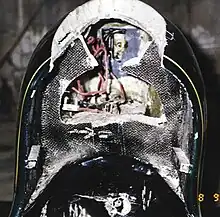
Following Chevrolet's stepping down as national sponsor, Derby Downs was beset by a cheating scandal that threatened to damage its credibility as a trusted American institution. In 1973, World Champion Jimmy Gronen, 14, of Boulder, Colorado was stripped of his title just two days after being crowned the winner after he was caught cheating.[2] Unusual discrepancies surrounding Gronen's margins of victory and heat times tipped off Derby officials, and an investigation of his car (pictured left) was conducted using X-ray examination, which revealed an electromagnet in the nose of the car, along with electrical wires connected it to a battery. By Gronen leaning his helmet against a switch hidden in the helmet faring (pictured right) of the car's body, the electromagnet became charged, effectively making the nose of the car grab the steel plate of the starting gate. When the gate swung forward, freeing the cars so they could start their run, Gronen's car was pulled forward as well, giving it a boost. Videotape of the race showed a suspiciously sudden lead for Gronen just a few feet after each heat began. Other suspicions were Gronen's heat times progressively slowing down as the race wore on—heat times usually get faster each time a racer completes a heat—as the battery drained power each time the circuit was closed, reducing the effectiveness of the magnet. The margin of victory for a race heat is normally no more than 1 to 3 feet (0.30 to 0.91 m). Gronen's early heat victories were in the 20 to 30 feet (6.1 to 9.1 m) range.[72]
Midway through the race, Derby officials also replaced Gronen's wheels after chemicals were found to be applied to the wheels' rubber. The chemicals caused the tire rubber to swell, which reduced the rolling resistance of the tire. In the final heat, Gronen finished narrowly ahead of Brent Yarborough, who was declared the 1973 champion two days later.
Gronen's uncle and legal guardian at the time, wealthy engineer Robert Lange, was indicted for contributing to the delinquency of a minor and paid a $2,000 settlement.[73]
Derby rebuilds
By the end of the year the Akron Chamber of Commerce severed ties with the Derby Downs, which now needed a new sponsor. The next month the Akron Jaycees Junior Chamber of Commerce instituted the "Save the All-American Committee", which became the All-American Soap Box Derby, Inc. led by Ron D. Baker, general manager at Derby Downs from 1974 till 1977.[74] In preparation for the 1974 season, new rules were instituted to govern against the possibility of a repeat of previous year's cheating scandal. The gates at the starting line were rendered magnet-proof, and pre-race inspections now involved questioning the boys to verify whether they did in fact construct their racers. The cars themselves had to be constructed in a way that judges could now inspect their interiors from front to back to uncover anything suspect, meaning access doors had to be designed into the car bodies, usually over the front and rear axles. Local sponsors sending a champion to the Akron had to sign an affidavit attesting to the legal compliance of the car being shipped.[75]
The 1974 All-American race was a success, though again the attendance had dropped, and three cars were disqualified, receiving protests from parents, yet praise from others wanting to protect the integrity of the Derby.[76] Curt Yarborough,[lower-alpha 19] 11, of Elk Grove, CA was crowned World Champion[77] in a field of 99 entries, and claiming the first back-to-back win of siblings at the All-American, following his younger brother Brent Yarborough,[lower-alpha 20] who won the year prior. [78]
New sponsor
As the 1975 season was winding down, the Soap Box Derby still had no sponsor. In late November Barberton, OH firm Novar Electronics pledged $165,000 for the All-American the following year, almost double what was spent on the previous two years combined. Novar president James H. Ott felt that loosing a popular institution like the Soap Box the Derby in Akron would be a tragedy, especially during America's bi-centennial,[79] admitting that most of the management personal, including himself, were born in Akron. The agreement with Derby Downs was to continue with the annual contribution, stipulating that it would give a three-year lead time if Novar intended to end its sponsorship, avoiding the shock of Chevrolet's stepping down a few years prior.[80] Novar's annual contributions continued until 1988[2] when a fiscal downturn forced them to withdraw.
Junior Division

Following the girl's entry into the sport that culminated in Karren Stead's World Championship win in 1975, Derby Downs implemented another big change to the All-American with the introduction in 1976 of a new race category, the Junior Division.[50] Open to kids ages ten through twelve, it became an entry-level tier with an entirely new, "patterned"[81] car design (pictured) sold as a kit, with easy-to-follow instructions, and included everything except the wood and tools to build a complete racer. This gave kids an easier way to construct a car, a "back-to-basics"[81] initiative that held firm to Derby Down's "kid-built" rule whilst supplementing its coffers from sales of the kits, priced at $36.95.[82][83] Measurement restrictions remained the same, with an overall length of 80 inches (200 centimetres). Unlike previous racers, the axles were kept exposed—without aerodynamic airfoils, and came with stabilizer braces or radius rods for the rear axle. The kit instructions offered several body designs from which to choose, but the general configuration was a flat-top car with a teardrop-shaped floor board, to which were affixed squared wooden bulkheads enclosed in a plywood skin. A standardized steering wheel was included in the kit. In 1981 kids had the option of purchasing from Derby Downs a pre-fabricated fiber glass body shell, making car construction again much easier for kids, or they could continue to make one from wood.[84] Kids ages twelve[lower-alpha 21] through fifteen, now identified as the Senior Division, would continue to construct cars from scratch. This now meant that the All-American would crown two champions, a Junior and Senior, making Karren Stead the last sole Champion at the All-American. Champions for 1976 were Joan Ferdinand[lower-alpha 22] of Canton, OH in the Senior Division and Phil Raber[lower-alpha 23] of New Philadelphia, OH in the Junior. 1976 also had the distinction of allowing the return of windscreens, permitted on Junior cars only—Raber's champ car had one—but this was discontinued the following year and has remained so ever since.
Late 70s
In 1979 the rules stipulated that axles remain exposed on the Senior Division cars like they were on the Juniors. In response, builders installed taught wires between the nose of the car and the front wheels, called "Kite steering" to improve aerodynamics that were lost when airfoils over the axles were disallowed. 1979 Senior World Champion Craig Kitchen with his car[lower-alpha 24] was fitted in this way.
Expansion
The years leading into the 21st Century were occupied by administrative efforts of the Soap Box Derby to maintain fiscal solvency, with Derby Downs continuing to secure a national sponsor. In 1988 Novar's twelve-year financial campaign supporting the Derby ended, but First National Bank of Ohio,[85] quickly stepped up with support of $175,000 per year for two years, plus $25,000 for promotions.[86] This was followed by candy maker Leaf, Inc. from 1993 to 1994. In 1998 Goodyear made contributions as a national sponsor, with NASCAR partnering with Home Depot and Levi Strauss Signature from 2002 to 2007 in support of the Derby. In 2012 FirstEnergy joined the effort with continued support through 2023.[2]
Following the creation of the second Junior Division in 1976, the names of the divisions were changed, with Senior becoming the Masters Division, and Junior becoming the Kit Car Division. Pursuant to that the first fully pre-fabricated kit racer, which meant that kid no longer had to build a car from scratch, was introduced. Designed by 1967 World Champion Ken Cline, it comprised a fiberglass body shell, floorboard, axles and hardware that a child could assemble in four hours.[2]
A third division
To expand enrollment further, Derby introduced a third category in 1992, called the Stock Division,[11] which now became the entry-level tier for drivers, with the Kit Car Division elevated to a new middle-category. This meant that there would be three champions at the All-American instead of two, each representing their division.[87] The Masters racer remained the only non-kit car that racers had to fabricate from scratch until 1999, when a prefabricated Masters kit, called the "Scottie" was made available for sale.
Since 1976, the top-tier Senior/Master Division cars were fully-reclined lay-down designs, while the Junior and Kit cars remained sit-ups. In the mid-90s however, many Masters cars returned to the sit-up configuration, with James Marsh winning the 1998 Masters Division World Championship in a sit-up design. By the time the "Scottie" Masters Division kit, named after Derby creator Myron Scott, was introduced in 2001, the top-tier cars have remained full lay-downs ever since. Today the three Official Divisions of the Soap Box Derby are Stock (formerly Junior), Super Stock, (formerly Kit) and Masters.
Rally Division
In 1986 the Rally Division was introduced,[50] created as a "grand-prix style" race to give competitors greater experience and the ability to race in more competitions outside their own local community. Racers would compete in a district, of which there were ten in all, amassing points while competing at several races in that district. The highest-scoring car from each district would compete at the Rally World Championship, inaugurated in 1993.[2]
International Derby
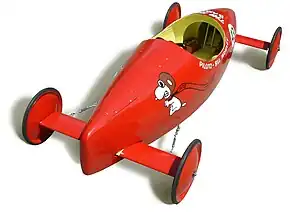
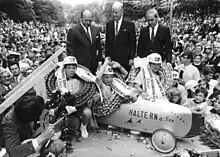
In 1936 the Soap Box Derby became an international affair when cars from outside the US participated at the All-American National race in Akron, with a competitor from South Africa in 1936[2][87] and another from Canada in 1937. Three cars from abroad entered in 1938: Canada, Hawaii (not yet a US State) and Panama, although Hawaii was permitted to participate as an American entry. Other participants since then have included Germany, Guam, Ireland,[88] Japan, New Zealand, the Philippines, Puerto Rico and Venezuela.
Canada was one of the earliest entries into organizing its own local races outside the US, chief among them the Kinsmen Coaster Classic, which debuted in Montreal in 1938.[89] Two of Canada's most prominent entries were Mission City (now Mission, BC), and St. Catharines, ON, both of whom were affiliated with the Soap Box Derby as official franchises and were qualified to sent champs to the All-American in Akron. Mission acquired the rights to the Western Canada Soapbox Derby Championships in 1946 and the Mission Regional Chamber of Commerce, previously named the Mission City & District Board of Trade, organized the event annually until 1973.[90] It resumed again in 1999.[91] St. Catharines ran races from 1947[92] till 1972. From among Canada's many attempts at capturing a World Championship, St. Catharines fared the best at Derby Downs, with Andy Vasko taking third place at the 20th All-American in 1957 against 158 other competitors.[93] In the non-competitive category honoring technical achievements, St. Catharines' Ken Thomas took home the Best Construction Award at the 30th All-American in 1967. Today Canada remains active in various communities across the nation and continues to send participants to Akron.
Germany, the most active member of the international Derby community, began races in 1949 in what was then the US-occupation zone of Germany and Berlin. Its national sponsor was Adam Opel Automobile Works, which took over from US Armed Forces in 1951,[94] and supplied the official wheels used on the cars. Over the next ten years this led to 214 communities sending local champs to the German Nationals, its overall champion representing Germany at the All-American in Akron. Derby remains active in Germany.
Modern Derby
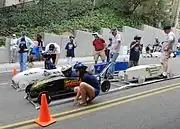
Using standardized wheels with precision ball bearings, modern gravity-powered racers start at a ramp on top of a hill, attaining speeds of up to 35 miles per hour. Rally races and qualifying races in cities around the world use advanced timing systems that measure the time difference between the competing cars to the thousandth of a second to determine the winner of a heat. Each heat of a race lasts less than 30 seconds. Most races are double elimination races in which a racer that loses a heat can work their way through the Challenger's Bracket in an attempt to win the overall race. The annual World Championship race in Akron, however, is a single elimination race which uses overhead photography, triggered by a timing system, to determine the winner of each heat. Approximately 500 racers compete in two or three heats to determine a World Champion in each divisions.
There are three racing divisions in most locals and at the All-American competition.[50] The Stock division is designed to give the first-time builder a learning experience. Boys and girls, ages 7 through 13, compete in simplified cars built from kits purchased from the All-American. These kits assist the Derby novice by providing a step-by-step layout for construction of a basic lean forward style car. The Super Stock Car division, ages 9 through 18, gives the competitor an opportunity to expand their knowledge and build a more advanced model. Both of these beginner levels make use of kits and shells available from the All-American. These entry levels of racing are popular in race communities across the country, as youngsters are exposed to the Derby program for the first time. The Masters division offers boys and girls, ages 10 through 20, an advanced class of racer in which to try their creativity and design skills. Masters entrants may purchase a Scottie Masters Kit with a fiberglass body from the All-American Soap Box Derby.[95]
In 2021, Johnny Buehler, from Warrensburg, Missouri, became at the time the youngest racer to win the All-American Soap Box Derby Local Stock Division. He was eight years old at the time of his win.[96]
Ultimate Speed Challenge
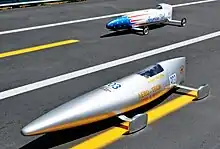

The Ultimate Speed Challenge is an All American Soap Box Derby sanctioned racing format that was developed in 2004 to preserve the tradition of innovation, creativity, and craftsmanship in the design of a gravity powered racing vehicle while generating intrigue, excitement, and engaging the audience at the annual All-American Soap Box Derby competition.[97] The goal of the event is to attract creative entries designed to reach speeds never before attainable on the historic Akron hill. The competition consists of three timed runs (one run in each lane), down Akron's 989-foot (301 m) hill. The car and team that achieve the fastest single run is declared the winner. The timed runs are completed during the All American Soap Box Derby race week.
The open rules of the Ultimate speed Challenge have led to a variety of interesting car designs.[98][99] Winning times have improved as wheel technology has advanced and the integration between the cars and wheels has improved via the use of wheel fairings. Wheels play a key role in a car's success in the race. Wheel optimization has included a trend towards a smaller diameter (to reduce inertial effects and aerodynamic drag), the use of custom rubber or urethane tires (to reduce rolling resistance), and the use of solvents to swell the tires (also reducing rolling resistance). There is some overlap in technology between this race and other gravity racing events, including the buggy races race at Carnegie Mellon University.[100]
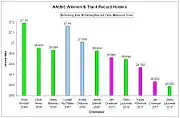
In 2004, during the inaugural run of the Ultimate Speed Challenge, the fastest time was achieved by a car designed and built by the Pearson family, driven by Alicia Kimball, and utilizing high performance pneumatic tires. The winning time achieved on the 989-foot (301 m) track was 27.190 seconds.
Jerry Pearson returned to defend the title with driver Nicki Henry in the 2005 Ultimate Speed Challenge beating the 2004 record time and breaking the 27.00 second barrier with an elapsed time of 26.953 seconds. Second place went to the DC Derbaticians with a time of 27.085 while third went to Talon Racing of Florida with a time of 27.320.[101]
John Wargo, from California, put together the 2006 Ultimate Speed Challenge winning team with driver Jenny Rodway. Jenny set a new track record of 26.934 seconds. Jenny's record stood for 3 years as revisions to the track and ramps after the 2006 race caused winning times to rise in subsequent races. Team Pearson finished 2nd with a time of 26.999 seconds and team Thomas finished 3rd with a time of 27.065.[102]
Team Eliminator, composed of crew chief and designer Jack Barr and driver Lynnel McClellan, achieved victory with a time of 27.160 in the 70th (2007) All-American Soap Box Derby Ultimate Speed Challenge. Jenn Rodway finished 2nd with a time of 27.334 while Hilary Pearson finished 3rd with a time of 27.367.[103]
Jack Barr returned in 2008 with driver Krista Osborne for a repeat team win with a 27.009 second run. Crew chief Tom Schurr and driver Cory Schurr place second with a time of 27.023 while crew chief Mike Albertoni and driver Danielle Hughes were 3rd after posting a time of 27.072.[104]
In the 72nd (2009) AASBD Ultimate Speed Challenge, Derek Fitzgerald's Zero-Error Racing team, with driver Jamie Berndt, took advantage of a freshly paved track, and set a new record time of 26.924 seconds. Cory Schurr placed second with a time of 26.987. Laura Overmyer of clean sheet racing finished third with a time of 27.003.
In 2010, Mark Overmyer's Clean Sheet/Sigma Nu team (CSSN) and driver Jim Overmyer set the track record at 26.861 seconds in the first heat of the opening round. Several minutes later, driver Sheri Lazowski, also of CSSN, lowered the record to 26.844 seconds, resulting in victory by 0.005 seconds over 2nd-place finisher Jamie Berndt of Zero Error. Competition was tight in 2010, with the top 3 cars finishing within a span of 0.017 seconds.[97]

In 2011, advancements in wheel technology and car design, coupled with ideal track conditions, lead to significantly lower times in the Ultimate Speed Challenge. Driver Kayla Albertoni and crew chief Mike Albertoni broke the record in heat 2 or the opening round with a 26.765, taking 0.079 seconds off the 2010 record. One heat later, driver Jim Overmyer and crew chief Mark Estes of team CSSN racing lowered the record a further 0.133 with a 26.632 run. Jim improved to 26.613 in round 2 to secure 2nd place. In heat 5, of the opening round, driver Kristi Murphy and crew chief Pat Murphy secured 3rd place with a run of 26.677. In the next heat, driver Sheri Lazowski (pictured) and crew chief Mark Overmyer (of CSSN racing) took the victory with a blistering run of 26.585 seconds. Sheri's record time was 0.259 seconds under her 2010 record and 0.339 seconds below the 2009 record. Her improvement in 2011 is the largest year-to-year change in the record in the history of the AAUSC race.[106] By winning in both 2010 and 2011, Sheri became the first repeat USC winner.
In 2012, revised starting ramps and a re-sealed track with a softer road surface, led to significant increases in finishing times. The 2012 winner, Laura Overmyer of CSSN racing, with crew chief Mark Estes, posted a winning time of 26.655 seconds, 0.070 seconds slower than the track record set by her team the prior year. Kristi Murphy, of Zero Error racing, finished in 2nd with a time of 26.769, 0.114 seconds back. Jamie Berndt, also of Zero Error racing, finished in 3rd place with a time of 26.827. Competition was not as close as in recent years, with the top 3 cars covering a span of 0.172 seconds. This is roughly double the span in 2009 and 2011 and 10 times the span in 2010. The 2012 results mark the 3rd consecutive win by CSSN racing and the 4th consecutive win by wheel expert Duane Delaney.[107][108]
The 2013 race was run under wet conditions which necessitated a format change. Each car was given a single run from lane 2 to determine the winner. The running order was randomly determined. CSSN Racing's Anne Taylor with crew chief Jerry Pearson won with a time of 26.929. Jillian Brinberg and crew chief Mark Estes, also of CSSN Racing, finished 2nd with a time of 26.978. Catherine Carney with crew chief Lee Carney finished 3rd with a time of 27.162.[109]
In 2014, CSSN's Anne Taylor with crew chief Jerry Pearson won with a time of 26.613. Anne's time improves on the prior best time for the new gate configuration but falls short of the 2011 record. This marks Anne's 2nd consecutive win and the 5th consecutive win for CSSN racing in this event. CSSN's Tucker McClaran with crew chief Mark Estes finished second with a time of 26.667. Catherine Carney with crew chief Lee Carney finished 3rd with a time of 26.750.
Preserving Derby
Undoubtedly Soap Box Derby's greatest legacy is each participant's memory of their experience when racing and working in a supportive parent/child environment. Its most visible legacy however is the assortment of kid-built cars that still exist, now retired to the attics, basements and garages of uncounted American households,[21] not to mention the plethora of programs, buttons, flags, jerseys, banners, posters and a countless assortment of keepsakes and take-away items found on eBay.[110] Most cars constructed in the previous century were one-of-a-kind creations and therefore each quite unique, and over time have become collectible items that end up on display in private residences or public venues like bars and restaurants as examples of American memorabilia to be cherished and preserved.
Derby cars on public display

Museums and historical societies have or are currently exhibiting Derby cars or adding them to their permanent collections, usually acquired via donation by the cars' original owners.[lower-alpha 25] Examples of such collections are the All-American Soap Box Derby Hall of Fame Museum in Akron, OH;[115] the Museum of American Speed in Lincoln, NE;[116] the Vortaunus Museum in Oberursel (Taunus), Germany;[117] the Virginia Museum of Transportation (pictured to the right) in Roanoke, VA; Memory Lane Museum in Mooresville NC;[118] and the Lancaster Soap Box Derby Hall of Fame Museum (pictured below), though many more have as few as a single car. Presently the St. Catharines Museum & Welland Canals Centre in St. Catharines, ON, Canada is hosting an exhibit on the Soap Box Derby through 2023.[119] The gallery below features examples of cars that have been exhibited or are in permanent collections.





 1971 Lima, OH Champion James Ethan Jackson's racer at the Allen County Museum and Historical Society in Lima, OH[121]
1971 Lima, OH Champion James Ethan Jackson's racer at the Allen County Museum and Historical Society in Lima, OH[121]
 1936 Peekskill, NY Champion William Barthelmes' car in the Marion Boyle Children's Room at the Peekskill Museum[127]
1936 Peekskill, NY Champion William Barthelmes' car in the Marion Boyle Children's Room at the Peekskill Museum[127]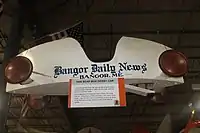 1950 Bangor, ME Champion James Roy on display at the Cole Land Transportation Museum in Bangor, ME[128]
1950 Bangor, ME Champion James Roy on display at the Cole Land Transportation Museum in Bangor, ME[128]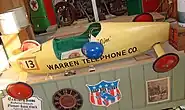 1961 Warren, OH class A racer James Chadwick's car on exhibit at the End of the Commons General Store in Mesopotamia, OH
1961 Warren, OH class A racer James Chadwick's car on exhibit at the End of the Commons General Store in Mesopotamia, OH Lancaster's Champions on display at their Hall of Fame Museum located a few mile south of Lancaster, OH
Lancaster's Champions on display at their Hall of Fame Museum located a few mile south of Lancaster, OH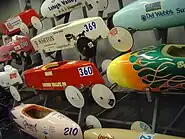 A 2010 exhibit at the America on Wheels Auto Museum in Allentown, PA[129]
A 2010 exhibit at the America on Wheels Auto Museum in Allentown, PA[129] 1961 Mission City, BC, Canada Champion Raymond Mack's racer exhibited in 2020 at the Mission Museum in Mission, BC
1961 Mission City, BC, Canada Champion Raymond Mack's racer exhibited in 2020 at the Mission Museum in Mission, BC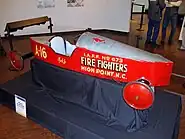 1953 High Point, NC racer Henry Clyde Williams, Jr.'s car at the High Point Museum in High Point, NC in February and March, 2023[130]
1953 High Point, NC racer Henry Clyde Williams, Jr.'s car at the High Point Museum in High Point, NC in February and March, 2023[130]
Annual Vintage Derby Car Show
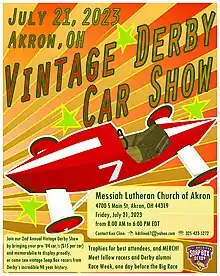
In 2022 the Inaugural Vintage Derby Car Show[131] was held in Akron, OH, the first of its kind to showcase extant vintage racers.[132] This was an open invitation to any and all Derby alumni that wished to attend with their old car or cars and keepsakes like trophies, pins and jerseys. Headed by 1967 All-American World Champion and 2017 AASBD Hall of Fame inductee Ken Cline,[133][134] the one day event comprised twenty seven cars during Soap Box Derby Race Week, one day prior to the All-American World Championship. The following year the 2nd Annual Vintage Car Show displayed thirty one cars in a larger venue, with ten trophies hand crafted by Mr. Cline awarded to the best presentations that day.[135]
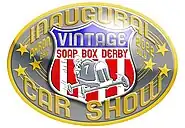 Inaugural Vintage Derby Car Show commemorative belt buckle design
Inaugural Vintage Derby Car Show commemorative belt buckle design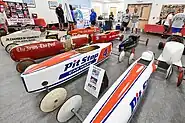 An array of classic designs at the 2022 Inaugural Vintage Derby Car Show in Akron, OH on July 22, 2022
An array of classic designs at the 2022 Inaugural Vintage Derby Car Show in Akron, OH on July 22, 2022 Oldest car at the 2023 2nd Annual Vintage Derby Car Show, piloted by Indianapolis, IN Champion David M. Knight in 1953[136]
Oldest car at the 2023 2nd Annual Vintage Derby Car Show, piloted by Indianapolis, IN Champion David M. Knight in 1953[136]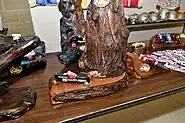 Trophy table at the 2023 Derby Show, featuring ten trophies hand-crafted by event organizer Ken Cline
Trophy table at the 2023 Derby Show, featuring ten trophies hand-crafted by event organizer Ken Cline
Notes, citations and sources
Notes
- Popular during the Great Depression, a soapbox car was a hand-built, kid-sized push car or racer constructed from anything like tin plate and bits of discarded wood crate mounted to a pair or set of wheels that kids rode around on.
- This event was captured on film in the 1914 American silent short Kid Auto Races at Venice, starring Charlie Chaplin in his first Little Tramp character appearance in cinema. It featured an organized event that saw kids racing down a tall wooden ramp before a large crowd.[8]
- Referred to in 1933 as "Soap Box Race," not "Soap Box Derby," which started in 1934
- 1st venue: Burkhardt Hill, Dayton, OH[13]39°45′38″N 84°08′34″W
- 2nd venue: Tallmadge Hill, Akron, OH 41°06′07″N 81°28′08″W
- 3rd venue: Derby Downs, Akron, OH 41°02′20″N 81°27′26″W
- Madison, WI Champion Van Steiner, who began racing at age 11, constructed a car for each year he raced until he won in 1957, his last year of eligibility before turning 16.[41][42]
- Arguably the biggest complaint among Derby families was with competitors showing up at the track with cars that looked too good to be 'kid-built.'
- Image of 1951 World Champion Derwin Cooper's car
- Image of 1963 World Champion Harold Conrad's car
- Image of 1940 World Champion Thomas Fisher with his car
- Image of 1970 Warren, OH Champion Kevin Lamb's car with sight grooves
- Image of 1967 World Champion Ken Cline with his car
- Image of 1970 World Champion Sam Gupton in his car at the starting line
- Image of 1969 World Champion Steve Souter's car
- Image of 1936 World Champion Herbert Muench's car
- Made from 43% fiber glass[46]
- Image of 1976 World Champion Karren Stead in her arm cast, standing with her car
- Image of 1974 World Champion Curt Yarborough's car
- Image of 1973 World Champion Brent Yarborough's car
- Twelve-year-olds had the option or racing as a Junior or Senior Division entry.[83]
- Image of 1976 Senior World Champion Joan Ferdinand (holding plaque) with her family and car
- Image of 1976 Junior World Champion Phil Raber with his car
- Image of 1979 Senior World Champion Craig Kitchen with his car
- 1951 Hartford, CT Champion Denny Zimmerman,[112] 1955-56 Warsaw, IN racer Larry Shively[113] and Orviston, PA racer Steve Rhoads[114] donated their cars.
Citations
- "Trademarks". "Soap Box Derby".
- "75 facts about the All-American Soap Box Derby". "Akron Beacon Journal".
- "FEAASBD". "Soap Box Derby".
- "Staff". "Soap Box Derby".
- Payne 2003, p. 166.
- Reed 2013, p. ix.
- "Getting started". "Soap Box Derby".
- Lehrman, Henry. "Kid Auto Races at Venice". IMDb. Retrieved 22 August 2023.
- "Oakwood Boys 'Spontaneous' Idea Grew and Grew". "Dayton Journal Herald". 14 August 1948.
- "First Winner Recalls Big Hill Road Race in 1933". "Dayton Journal Herald". 18 July 1966.
- "First Soap Box Derby Champion". "Dayton Daily News". 27 May 2008.
- "Scotty's back home". "Dayton Journal Herald". 10 May 1973.
- "Dayton Embraced Soap Box Derby". "Dayton Daily News". 20 Jul 2003.
- "Si'ings". "Dayton Daily News". 2 September 1973.
- Reed 2013, p. 2.
- Rosenthal 1980, p. 49.
- "History". "Soap Box Derby".
- Reed 2013, p. 3.
- "Here are Winners in National and State Soap Box Races". "Dayton Daily News". 20 Aug 1934.
- "Soap Box Derby Gets Permanent Home". "Soap Box Derby".
- Payne 2003, p. 78.
- Payne 2003, p. 144.
- Payne 2003, p. 6.
- "A Child’s Life in the 1930s Compared to Today". "Children's Theatre".
- Payne 2003, p. 22.
- Payne 2003, p. 18.
- Payne 2003, p. 79.
- Payne 2003, p. 146.
- "Engineer Give Soap Box Derby Trophy". "Dayton Daily News". 5 Aug 1934.
- "Former Chevy Boss M. E. Coyle is Dead". "Akron Beacon Journal". 28 Sep 1961.
- "Local Champion's Plaque". "Lubbock Evening Journal". 3 Jul 1950.
- "Wheel Shortage in Derby Accute". "New Brunswick Home News". 12 Jul 1937.
- "Derby, in Sixth Year, has Enjoyed Amazing Growth in Popularity". "Akron Beacon Journal". 13 Aug 1939.
- "Gearing up as Soap Box Derby parade, races return to Akron". "Akron Beacon Journal". 15 Jul 2023.
- "U.S. History Primary Source Timeline". "Library of Congress".
- "West Coast Boy Derby King". "Akron Beacon Journal". 19 Aug 1946.
- Iula & Ignizio 2011, p. 32.
- Rosenthal 1980, p. 110.
- Iula & Ignizio 2011, p. 73.
- Rosenthal 1980, p. 70.
- "1957 Soap Box Derby Racer". "Wisconsin Historical Society".
- "Parade Float with Soap Box Derby Cars". "Wisconsin Historical Society".
- Payne 2003, p. 80.
- Payne 2003, p. 82.
- Rosenthal 1980, p. 76.
- "Derby cars: New shapes, same speed". "Akron Beacon Journal". 8 Aug 1982.
- Iula & Ignizio 2011, p. 102, 104 & 106.
- "Soap Box Derby Set For Tonight". "Greenville News". 25 Jul 1975.
- "Rules Not Official Until November Meeting: Wheel Sizes". "Akron Beacon Journal". 15 Oct 1936.
- Iula & Ignizio 2011, p. 78.
- Payne 2003, p. 184.
- "Attention Boys and Girls". "Davenport Daily Times". 3 Aug 1936.
- "Soap-Box Racers May Get Wheels". "Muncie Star Press". 1 Jun 1936.
- "Soap Box Derby Introduces New Wheel for Race Competition". "Soap Box Derby".
- Fulton 1994, p. 3-7.
- "Annual derby fun for 38 kids, families". "Lancaster Eagle-Gazette". 26 Jun 2016.
- "Go, speed racers, go!". "Akron Beacon Journal". 22 Jul 2015.
- "62 to compete for derby titles". "Dover Daily Reporter". 23 Jun 1977.
- "Fun, excitement of Soap Box Derby never changes". "Vidette-Messenger of Porter County". 19 Jun 1994.
- "'Timer swap' system in derby is criticized as time consuming". "Akron Beacon Journal". 24 Jun 1983.
- "Little mysteries from the Soap Box Derby". "Akron Beacon Journal". 9 Jul 2023.
- Payne 2003, p. 115.
- Payne 2003, p. 113.
- "Not Just a 'Boy's Race". "Akron Beacon Journal". 24 Jul 2021.
- Payne 2003, p. 185.
- Rosenthal 1980, p. 51-52.
- "Girl Wins Soap Box Derby". "Detroit Free Press". 17 Aug 1975.
- "Soap Box Derby 'Didn't fit in contemporary America'". "Akron Beacon Journal". 15 Sep 1973.
- "Hopes Brighten For Continuing Soap Box Derby". "Akron Beacon Journal". 11 Oct 1972.
- "All-American Soap Box Derby: A look Back". "Akron Beacon Journal". 3 Aug 1997.
- "Derby Hopes are Brightened". "Akron Beacon Journal". 10 Oct 1972.
- "Anything to Win: The All-American Soap Box Derby Scandal" (episode 6 of the GSN documentary series)
- "Akron Chamber Withdraws Soap Box Derby Sponsorship". "The Mercury". 29 Dec 1973.
- Rosenthal 1980, p. 84.
- Rosenthal 1980, p. 86.
- "Derby Aides Say Fuss May Help". "Akron Beacon Journal". 10 Sep 1974.
- Payne 2003, p. 186.
- "Derby Crown Remains in Calif. Family". "Lancaster, PA Sunday News". 18 Aug 1974.
- "Barberton company saves Soap Box Derby". "Akron Beacon Journal". 24 Nov 1975.
- "Happy beginning set by soap-box savior". "Akron Beacon Journal". 25 Nov 1975.
- "Looking Good". "Akron Beacon Journal". 21 Jul 1976.
- "Golf, school shift date of derby to Aug. 14". "Akron Beacon Journal". 16 Feb 1976.
- "Soap Box Derby Wants You to Believe!". "Columbus Ledger-Enquirer". 29 Jan 1976.
- "Soap-Box Cars Will Head for the Hill". "Omaha World-Herald". 13 Jul 1984.
- "First National Bank is proud sponsor of Derby". "Akron Beacon Journal". 7 Aug 1989.
- "Soap Box Derby". "Akron Beacon Journal". 7 Aug 1989.
- "Get up to speed on seven decades of derby history". "Akron Beacon Journal". 15 Jul 2012.
- "Irish Champ". "Akron Beacon Journal". 3 Aug 1956.
- "11-Year-Old Hampstead Youth Wins First Local Soap Box Derby". "The Gazette". 10 Oct 1938.
- Cherrington 1974, p. 33, 172.
- "Mission Soapbox History". "Mission and District Soap Box Derby Association".
- "Everything “First” in St. Catharines History". "Facebook".
- "Here's Derby Prize List". "Akron Beacon Journal". 19 Aug 1957.
- "German Boy Coasts 30 MPH To Win Derby". "Akron Beacon Journal". 26 July 1954.
- "How The Derby Is Run". "Akron Beacon Journal". 3 Aug 1998.
- "Johnny Buehler becomes youngest Local Soap Box world champion". "Warrensburg Star-Journal".
- "Ultimate Speed Racing". "Wayback Machine".
- "Still More '08 Pictures". Archived from the original on 2011-11-14. Retrieved 2012-01-11.
- "2007 Pictures: Our Competitors". Archived from the original on 2011-11-14. Retrieved 2012-01-11.
- "separated at birth | CMU Buggy Alumni Association". Cmubuggy.org. Retrieved 2018-01-25.
- "Archived copy" (PDF). Archived from the original (PDF) on 2008-08-28. Retrieved 2012-04-03.
{{cite web}}: CS1 maint: archived copy as title (link) - "Archived copy" (PDF). Archived from the original (PDF) on 2008-08-28. Retrieved 2012-04-03.
{{cite web}}: CS1 maint: archived copy as title (link) - "Archived copy" (PDF). Archived from the original (PDF) on 2008-07-03. Retrieved 2012-04-03.
{{cite web}}: CS1 maint: archived copy as title (link) - "Ultimate Speed Division". Archived from the original on 2012-04-24. Retrieved 2012-04-03.
- The Tribune, Seymore, IN (July 25, 2011). "Soap Box Derby brings young racers to Akron@, p. 11
- "74th All-American Soap Box Derby Race Results". Aa Race. Archived from the original on 16 May 2012. Retrieved 2018-01-25.
- "2012 Ultimate Speed Challenge Heat Results.pdf". Retrieved 2018-01-25 – via Google Drive.
- "Archived copy" (PDF). Archived from the original (PDF) on 2013-08-21. Retrieved 2012-12-31.
{{cite web}}: CS1 maint: archived copy as title (link) - "All American Race Week | Race Results". Archived from the original on 2013-07-31. Retrieved 2013-07-31.
- Iula & Ignizio 2011, p. 108.
- The Daily News Leader (May 9, 2004). p. A10. Retrieved August 17, 2023.
- "Derby car sent to Indy 500 museum". "Akron Beacon Journal". 13 Oct 2007.
- "Remembering The Soap Box Derby". "Ink Free News".
- "Beech Creek/Marsh Creek Watershed Heritage Museum Group". "Facebook".
- "Soap Box Derby Hall of Fame Museum". All-American Soap Box Derby. Retrieved 19 August 2023.
- "Soapbox Derby". Museum of American Speed. Retrieved 19 August 2023.
- "Kinderautomobile und Seifenkisten". Vortaunus Museum. Retrieved 19 August 2023.
- Olson House, Karen. "A memorable museum celebrates motorsports and auto heritage". Carolina Country. Retrieved 18 August 2023.
- "Temporary Exhibits". "St. Catharines Museum and Welland Canals".
- "1939 Soap Box Derby Car - Artifact number 87.199.1". "The Henry Ford Museum".
- "Classic Soap Box Derby Racers (1933-1999)". "Sketchup 3D Warehouse".
- "Es Lebe der Sport". "Kassel.de - Stadtmuseum".
- "Racer, Derby - 1960 Derby Championship - Object number 2017.003.01". "Old State House Museum".
- "A little history from the Midwest". "Instagram - Okoboji Classic Cars".
- "Times Today: Soap box derby history lives on at Beaver Falls museum". "YouTube".
- "Car, Soap Box Derby: Object #H.2004.124.1". "North Carolina Museum of History".
- "Explore Exhibits – Marion Boyle Children's Room". "Peekskill Museum".
- "Motorcycles, Bicycles and Children's Toys". "Cole Land Transportation Museum".
- "Your View: America on Wheels optimistic about driving into future". "Allentown Morning Call". 27 May 2008.
- "Soap Box Derby Exhibit Opens at the High Point Museum". "Yes! Weekly".
- "Soap Box Derby memorabilia dating to first derby to be exhibited Friday". "Akron Beacon Journal".
- "2022 1st vintage car show". "Flickr".
- "Hall of Fame Members-Ken Cline". "Soap Box Derby".
- "Llano Soapbox Derby Hall of Famer Made It Possible for Every Kid to Follow in His Tracks". "101highlandlakes.com".
- "2nd Annual Vintage Car Show 2023". "Flickr".
- "151 Soap Box Derby Champions". "Indianapolis Star". 9 Aug 1953.
Sources
Books
- Cherrington, John (1 Jan 1974). Mission on the Fraser (1st ed.). Mitchell Press. ASIN B0006CL344. Retrieved 22 Sep 2023.
- Rosenthal, Sylvia A. (1980). Soap Box Derby Racing (1st ed.). Lorthop, Lee & Shepard Books. ISBN 978-0688519155. Retrieved 26 August 2023.
- Fulton, David (1994). Winning Ingredients for Soap Box Derby Racers (2nd ed.). CreateSpace Publishing. ISBN 9781482049343. Retrieved 26 Oct 2023.
- Payne, Melanie (2003). Champions, Cheaters, and Childhood Dreams: Memories of the Soap Box Derby. University of Akron Press. ISBN 978-1935603481. LCCN 2003008689. Retrieved 22 August 2023.
- Iula, Jeff; Ignizio, Bill (2011). How I Saw It: My Photographic Memory of the Soap Box Derby. University of Akron Press. ISBN 978-1935603078. Retrieved 22 August 2023.
- Reed, Ronald (2013). Tallmadge Hill: The story of the 1935 All-American Soap Box Derby (1st ed.). iUniverse Inc. ISBN 978-1475978575. Retrieved 24 August 2023.
- Reed, Ronald R. (2016). The All-American Soap Box Derby: A Review of the Formative Years – 1938 thru 1941. Arthur House. ISBN 978-1504977227. Retrieved 24 August 2023.
News
- "Engineer Give Soap Box Derby Trophy". Dayton Daily News. 5 Aug 1934. p. 6.
- "Here are Winners in National and State Soap Box Races". Dayton Daily News. 20 Aug 1934. p. 13.
- "Soap-Box Racers May Get Wheels". Muncie Star Press. 1 Jun 1936. p. 1.
- "Attention Boys and Girls". Davenport Daily Times. 3 Aug 1936. p. 13.
- Schlemmer, James W. (15 Oct 1936). "Rules Not Official Until November Meeting: Wheel Sizes". Akron Beacon Journal. p. 33.
- "Wheel Shortage in Derby Accute". New Brunswick Home News. 12 Jul 1937. p. 7.
- "11-Year-Old Hampstead Youth Wins First Local Soap Box Derby". The Gazette. 10 Oct 1938. p. 13.
- "Derby, in Sixth Year, has Enjoyed Amazing Growth in Popularity". Akron Beacon Journal. 13 Aug 1939. p. 11.
- "West Coast Boy Derby King". Akron Beacon Journal. 19 Aug 1946. p. 1.
- Owen, Bennett (14 August 1948). "Oakwood Boys 'Spontaneous' Idea Grew and Grew". Dayton Journal Herald. p. 10.
- "Local Champion's Plaque". Lubbock Evening Journal. 3 Jul 1950. p. 3.
- Shover, William (9 Aug 1953). "151 Soap Box Derby Champions". Indianapolis Star. p. 3.
- "German Boy Coasts 30 MPH To Win Derby". Akron Beacon Journal. 26 July 1954. p. 17.
- "Irish Champ". Akron Beacon Journal. 3 Aug 1956. p. 1.
- "Here's Derby Prize List". Akron Beacon Journal. 19 Aug 1957. p. 19.
- "Former Chevy Boss M. E. Coyle is Dead". Akron Beacon Journal. 28 Sep 1961. p. 55.
- Davies, James (18 July 1966). "First Winner Recalls Big Hill Road Race in 1933". Dayton Journal Herald. p. 3.
- "Derby Hopes are Brightened". Akron Beacon Journal. 10 Oct 1972. p. 33.
- "Hopes Brighten For Continuing Soap Box Derby". Akron Beacon Journal. 11 Oct 1972. p. 18.
- Young, Rox (10 May 1973). "Scotty's back home". Dayton Journal Herald. p. 39.
- Burick, Sy (2 September 1973). "Si'ings". Dayton Daily News. p. 45.
- Kuebler, Joseph (15 Sep 1973). "Soap Box Derby 'Didn't fit in contemporary America'". Akron Beacon Journal. p. 15.
- "Akron Chamber Withdraws Soap Box Derby Sponsorship". The Mercury. 29 Dec 1973. p. 16.
- "Derby Crown Remains in Calif. Family". Lancaster, PA Sunday News. 18 Aug 1974. p. 24.
- Bitterman, Susan (10 Sep 1974). "Derby Aides Say Fuss May Help". Akron Beacon Journal. p. 11.
- "Soap Box Derby Set For Tonight". Greenville News. 25 Jul 1975. p. 27.
- "Girl Wins Soap Box Derby". Detroit Free Press. 17 Aug 1975. p. 55.
- Downing, Bob (24 Nov 1975). "Barberton company saves Soap Box Derby". Akron Beacon Journal. p. 1.
- "Happy beginning set by soap-box savior". Akron Beacon Journal. 25 Nov 1975. p. 6.
- Simmons, Sandy (29 Jan 1976). "Soap Box Derby Wants You to Believe!". Columbus Ledger-Enquirer. p. 1.
- Downing, Bob (16 Feb 1976). "Golf, school shift date of derby to Aug. 14". Akron Beacon Journal. p. 40.
- Downing, Bob (21 Jul 1976). "Looking Good". Akron Beacon Journal. p. 17.
- "62 to compete for derby titles". Dover Daily Reporter. 23 Jun 1977. p. 13.
- Lawson, Gracie (8 Aug 1982). "Derby cars: New shapes, same speed". Akron Beacon Journal. p. 182.
- Peacock, Nancy (24 Jun 1983). "'Timer swap' system in derby is criticized as time consuming". Akron Beacon Journal. p. 16.
- "Soap Box Derby". Akron Beacon Journal. 7 Aug 1989. p. 61.
- "First National Bank is proud sponsor of Derby". Akron Beacon Journal. 7 Aug 1989. p. 61.
- Kosky, Ken (19 Jun 1994). "Fun, excitement of Soap Box Derby never changes". Vidette-Messenger of Porter County. p. 2.
- "How The Derby Is Run". Akron Beacon Journal. 3 Aug 1998. p. B3.
- "All-American Soap Box Derby: A look Back". Akron Beacon Journal. 3 Aug 1997. p. 8.
- Dyer, Stephen (1 Aug 1999). "Heated Heats!". Akron Beacon Journal. p. 9.
- Archdeacon, Tom (20 Jul 2003). "Dayton Embraced Soap Box Derby". Dayton Daily News. p. C1 & C7.
- Carney, Jim (13 Oct 2007). "Derby car sent to Indy 500 museum". Akron Beacon Journal. p. 45.
- Harris, Doug (27 May 2008). "First Soap Box Derby Champion". Dayton Daily News. p. B3.
- "Your View: America on Wheels optimistic about driving into future". Allentown Morning Call. 15 Sep 2010. p. 21.
- "Get up to speed on seven decades of derby history". Akron Beacon Journal. 15 Jul 2012. p. A001 & A004.
- Miller, Jimmy (22 Jul 2015). "Go, speed racers, go!". Akron Beacon Journal. p. B001.
- Thurston, Trista (26 Jun 2016). "Annual derby fun for 38 kids, families". Lancaster Eagle-Gazette. p. A3.
- Ashworth, Alan (14 Jun 2021). "Science, thrill of competition drive racers in local derby". Akron Beacon Journal. p. B1.
- Beans, Tawney (24 Jul 2021). "Not Just a 'Boy's Race". Akron Beacon Journal. p. B1.
- Price, Mark J. (9 Jul 2023). "Little mysteries from the Soap Box Derby". Akron Beacon Journal. p. B5.
- Clarke, Grace (15 Jul 2023). "Gearing up as Soap Box Derby parade, races return to Akron". Akron Beacon Journal. p. A1.
Websites
- "FEAASBD". Soap Box Derby. Retrieved 27 Aug 2023.
- "Getting started". Soap Box Derby. Retrieved 27 Aug 2023.
- "History". Soap Box Derby. Retrieved 28 Aug 2023.
- "Ultimate Speed Racing" (PDF). Wayback Machine. Retrieved 22 Sep 2023.
- "Soap Box Derby Gets Permanent Home". Soap Box Derby. Retrieved 26 Aug 2023.
- "Staff". Soap Box Derby. Retrieved 27 Aug 2023.
- "Trademarks". Soap Box Derby. Retrieved 27 Aug 2023.
- "U.S. History Primary Source Timeline". Library of Congress. Retrieved 18 Oct 2023.
- "Everything "First" in St. Catharines History". Facebook. Retrieved 22 Sep 2023.
- "Mission Soapbox History". Mission and District Soap Box Derby Association. Retrieved 22 Sep 2023.
- "1957 Soap Box Derby Racer". Wisconsin Historical Society. 31 Aug 2009. Retrieved 27 Sep 2023.
- "Parade Float with Soap Box Derby Cars". Wisconsin Historical Society. 31 Aug 2009. Retrieved 27 Sep 2023.
- Schleis, Paula (15 Jul 2012). "75 facts about the All-American Soap Box Derby". Akron Beacon Journal. Retrieved 26 Oct 2023.
- "Remembering The Soap Box Derby". Ink Free News. 24 Oct 2014. Retrieved 27 Sep 2023.
- O'Shea, Ryan (15 Feb 2017). "Times Today: Soap box derby history lives on at Beaver Falls museum". YouTube. Retrieved 14 Oct 2023.
- "1939 Soap Box Derby Car - Artifact number 87.199.1". The Henry Ford Museum. Retrieved 15 Oct 2023.
- "Es Lebe der Sport". Kassel.de - Stadtmuseum. Retrieved 15 Oct 2023.
- "Racer, Derby - 1960 Derby Championship - Object number 2017.003.01". Old State House Museum. 1 Mar 2017. Retrieved 15 Oct 2023.
- "Hall of Fame Members-Ken Cline". Soap Box Derby. 1 Jun 2017. Retrieved 14 Oct 2023.
- Fierro, Jennifer (14 Jun 2017). "Llano Soapbox Derby Hall of Famer Made It Possible for Every Kid to Follow in His Tracks". 101highlandlakes.com. Retrieved 14 Oct 2023.
- "Motorcycles, Bicycles and Children's Toys". Cole Land Transportation Museum. 13 Feb 2019. Retrieved 14 Oct 2023.
- "Car, Soap Box Derby: Object #H.2004.124.1s". North Carolina Museum of History. Retrieved 14 Oct 2023.
- "Explore Exhibits – Marion Boyle Children's Room". Peekskill Museum. 14 Oct 2019. Retrieved 14 Oct 2023.
- "Beech Creek/Marsh Creek Watershed Heritage Museum Group". Facebook. 19 Apr 2020. Retrieved 27 Sep 2023.
- "A little history from the Midwest". Instagram - Okoboji Classic Cars. 14 Jun 2020. Retrieved 15 Oct 2023.
- "A Child's Life in the 1930s Compared to Today". Children's Theatre. 28 Sep 2021. Retrieved 22 Sep 2023.
- Coan, Shannon (21 July 2022). "Soap Box Derby memorabilia dating to first derby to be exhibited Friday". Akron Beacon Journal. Retrieved 14 Oct 2023.
- Boyd, Kevin (29 July 2022). "2022 1st vintage car show". Flickr. Retrieved 14 Oct 2023.
- Andrews, Joe. "Johnny Buehler becomes youngest Local Soap Box world champion". Warrensburg Star-Journal. Retrieved 22 Sep 2023.
- Vaughan, Tamara (27 Jan 2023). "Soap Box Derby Exhibit Opens at the High Point Museum". Yes! Weekly. Retrieved 14 Oct 2023.
- "Soap Box Derby Introduces New Wheel for Race Competition". Soap Box Derby. 7 Jul 2023. Retrieved 30 Sep 2023.
- Boyd, Kevin (23 July 2023). "2nd Annual Vintage Car Show 2023". Flickr. Retrieved 14 Oct 2023.
- "Temporary Exhibits". St. Catharines Museum and Welland Canals. Retrieved 8 Oct 2023.
- "Classic Soap Box Derby Racers (1933-1999)". Sketchup 3D Warehouse. Retrieved 15 Oct 2023.
Further reading
- "Soap Box Racers Test Skill Of Boy Engineers" Popular Mechanics, July 1935 photos and drawing of original official rules and specification of racers
- "How To Win the Soap Box Derby" Popular Mechanics, April 1936, pp. 540–543 articles by VP of General Motors and by engineer for B.F. Goodrich